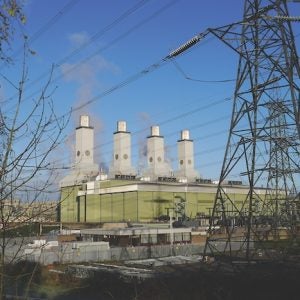
At 10 mm thick, the T15 robot is described as “ultra-thin” and indeed is said to be one of the “thinnest in the industry”, able to operate in air gaps down to 20 mm. It is designed for inspection of a wide range of generator sizes, including small units, which have proved difficult to inspect in the past, says Toshiba ESS.
The T15 robot is 325 mm long, 172 mm wide and it weighs about 0.75 kg.
It is magnetically attached to the stator core inner surface, using a stator slot as a guide for travelling in a straight line.
The T35 robot is larger and described as “multi-functional”, and can be used to inspect generators with ventilation segregation baffles attached to the stators, typically found in larger machines. These baffles have proved to be problematic for robotic inspection.
The T35 employs three arms that protrude from the stator side of the robot, holding it in position between the stator and rotor, pushing it against the rotor, enabling it to move over the rotor surface. The arms can be moved in and out to avoid the baffles.
The T35 robot is 33 mm thick (with arms folded in), 700 mm long, 315 mm wide, weight about 4.7 kg.
Toshiba Energy Systems and Solutions developed the inspection robots in 2018 and since then has been preparing for their commercialisation.
Early deployments of the ultra-thin robot included generator inspections in nuclear power plants and it is now available for the full range of applications. The multi-functional robots have been available for inspection services as from fiscal 2023.
In the past, turbine generator rotors were typically pulled from stators every four years for precision inspections, but the use of robotics, as well as NDT inspection technology that does not require a liquid contact medium, has reduced the need for rotor removal when looking for cracks and contributed to improved power plant load factors.
The T15 and T35 robots are equipped with top, bottom, front and rear high resolution cameras for VT (visual testing) of rotor and stator.
Examples of what visual examination of the stator core inner surface might show include: foreign material; scratches/damage; heating and arc indications. Rotor surface visual inspection can yield similar findings, as well as rotor wedge positions and plugging condition of rotor ventilation holes.
The robots enable cameras to be positioned on the centre lines of rotor ventilation holes, which is necessary for high quality inspection and diagnosis of rotor ventilation plugging issues (including automated image diagnostics).
The T35 robot can perform ultrasonic testing (UT) with a detachable UT attachment, employing Toshiba-developed dry-coupling technology rather than a liquid contact UT medium, leaving no contamination post-inspection.
Both robots are equipped with hammers for checking stator wedge tightness, with automated diagnostics based on acoustic analysis of the hammering sound, and high quality diagnostics are achieved, says Toshiba ESS.
Both robots can also be equipped with Chattock coils enabling them to perform ELCID (electromagnetic core imperfection detection).
Docking bay stations for the robots are installed on rotor retaining rings. The docking bay station inserts the robot into the air gap and moves it circumferentially. All robot movements, inspections and diagnostics are automated.
The quality of inspection that can be achieved by the new robots is said to be equivalent to that achieved by “inspection experts.”
The generator periodic major outage cycle (with rotor removal) can be extended, and preventive maintenance and planned repairs can be carried out based on an assessment of generator condition based on actual inspection data.
Toshiba ESS is using the new robots to help strengthen its service offering for fossil-fuelled and nuclear power plants worldwide.






